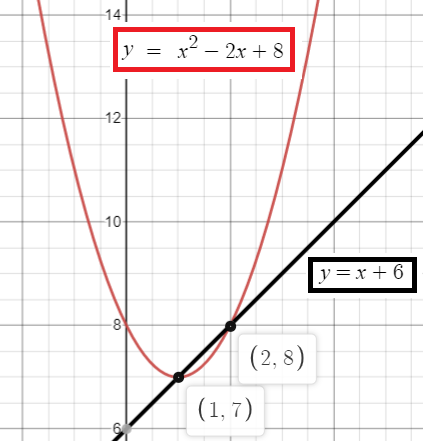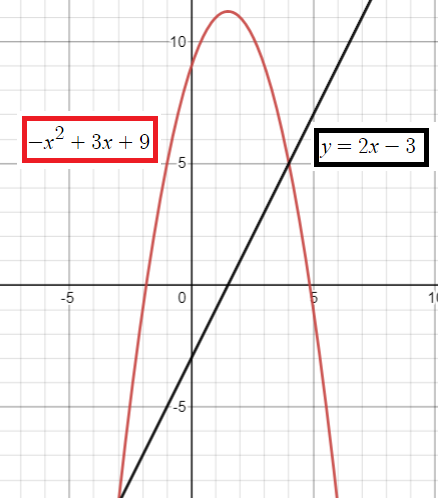SOLVING LINEAR AND QUADRATIC EQUATIONS
Subscribe to our ▶️ YouTube channel 🔴 for the latest videos, updates, and tips.
The graphical form of linear function is straight line and graphical form of quadratic function is a parabola.
By solving these two equations, we will get point of intersection of line and parabola.
How to solve linear and quadratic
equations ?
Step 1 :
We write the given two equations in the format
y = mx + c ----(1) y = ax2+bx +c ----(2)
Step 2 :
By equating (1) and (2), we will get quadratic equation in terms of x.
Step 3 :
By applying the value of x in any one of the equations, we can solve for y.
Step 4 :
The result is known as point of intersection of the curves.
Example 1 :
y = x2 – 2x + 8 and y = x + 6
Solution :
Given equations,
y = x2 – 2x + 8 -----(1)
y = x + 6 -----(2)
By applying y = x + 6 in equation (1), we get
x + 6 = x2 – 2x + 8
0 = x2 – 2x + 8 – 6 – x
x2 – 3x + 2 = 0
By factorization, we get
(x – 2) (x – 1) = 0
x = 2 and x = 1
|
When x = 2 y = x + 6 y = 2 + 6 y = 8 |
When x = 1 y = x + 6 y = 1 + 6 y = 7 |

So, the points of intersection are {(2, 8), (1, 7)}
Example 2 :
y = -x2 + 3x + 9 and y = 2x - 3
Solution :
Given equations,
y = -x2 + 3x + 9 -----(1)
y = 2x - 3 -----(2)
By applying y = 2x - 3 in equation (1), we get
2x - 3 = -x2 + 3x + 9
2x = -x2 + 3x + 9 + 3
0 = -x2 + 3x + 9 + 3 – 2x
x2 – 3x + 2x – 9 - 3 = 0
x2 – x – 12 = 0
By factorization, we get
(x – 4) (x + 3) = 0
x = 4 and x = -3
|
When x = 4 y = 2x - 3 y = 2(4) - 3 y = 5 |
When x = -3 y = 2x - 3 y = 2(-3) - 3 y = -9 |
So, the points are {(4, 5), (-3, -9)}

Example 3 :
y = x2 – 3x + 7 and y = x + 5
Solution :
Given equations,
y = x2 – 3x + 7 -----(1)
y = x + 5 -----(2)
By applying y = x + 5 in equation (1), we get
x + 5
= x2 – 3x + 7
x2 – 4x + 2 = 0
Now, we have a quadratic equation form. But there are no factors.
So, we find the x values by using the quadratic formula.
We get,
x = [-b ± √(b2 – 4ac)]/2a
Here a = 1, b = -4 and c = 2
x = [-(-4) ± √((-4)2 – 4(1)(2)]/2(1)
x = [4 ± √(16 – 8]/2
x = (4 ± √8)/2
x = [4 ± √(4×2)]/2
x = (4 ± 2√2)/2
x = [2(2 ± √2)]/2
x = 2 ± √2
Now, x = 2 + √2 and x = 2 - √2
|
When x = 2 + √2 y = 2 + √2 + 5 y = 7 + √2 |
When 2 - √2 y = 2 - √2 + 5 y = 7 - √2 |
So, the point of intersections are (2+√2, 7+2) and
(2-√2, 7-√2).
Example 4 :
y = x2 – 5x + 2 and y = x - 7
Solution :
Given equations,
y = x2 – 5x + 2 -----(1)
y = x – 7 -----(2)
By applying y = x - 7 in equation (1), we get
x = x2 – 5x + 2 + 7 + 7 – x
x2 – 6x + 9 = 0
By factorization, we get
(x – 3) (x – 3) = 0
x = 3
By applying x = 3 in equation (2), we get
y = x – 7
y = 3 – 7
y = -4
If x = 3 then y = -4
So, the solution is (3, -4)
Example 5 :
In the xy-plane, the graph of the equation
y = -x2 + 9x - 100
intersects the line
y = c
at exactly one point. What is the value of c?
Solution :
y = -x2 + 9x - 100
y = c
-x2 + 9x - 100 = c
-x2 + 9x - 100 - c = 0
a = -1, b = 9 and c = -(100 + c)
Since the parabola and the line is intersecting at one point, it should satisfy the condition
b2 - 4ac = 0
92 + 4(-1)(100 + c) = 0
92 - 4(100 + c) = 0
81 = 400 - 4c
81 - 400 = -4c
-319 = -4c
c = 319/4
So, the value of c is 319/4.
Example 6 :
x + 7 = 10
(x + 7)2 = y
Which ordered pair (x, y) is a solution to the given system of equations.
a) (3, 100) b) (3, 3) c) (3, 10) d) (3, 70)
Solution :
x + 7 = 10 ------(1)
Solving this, x = 10 - 7
x = 3
Applying the value of x
(x + 7)2 = y ------(2)
(3 + 7)2 = y
y = 102
y = 100
So, the solution is (3, 100). Option a is correct.
Subscribe to our ▶️ YouTube channel 🔴 for the latest videos, updates, and tips.
Kindly mail your feedback to v4formath@gmail.com
We always appreciate your feedback.
©All rights reserved. onlinemath4all.com
Recent Articles
-
10 Hard SAT Math Questions (Part - 38)
Dec 08, 25 12:12 AM
10 Hard SAT Math Questions (Part - 38) -
SAT Math Practice
Dec 05, 25 04:04 AM
SAT Math Practice - Different Topics - Concept - Formulas - Example problems with step by step explanation -
10 Hard SAT Math Questions (Part - 37)
Dec 03, 25 07:02 AM
10 Hard SAT Math Questions (Part - 37)


